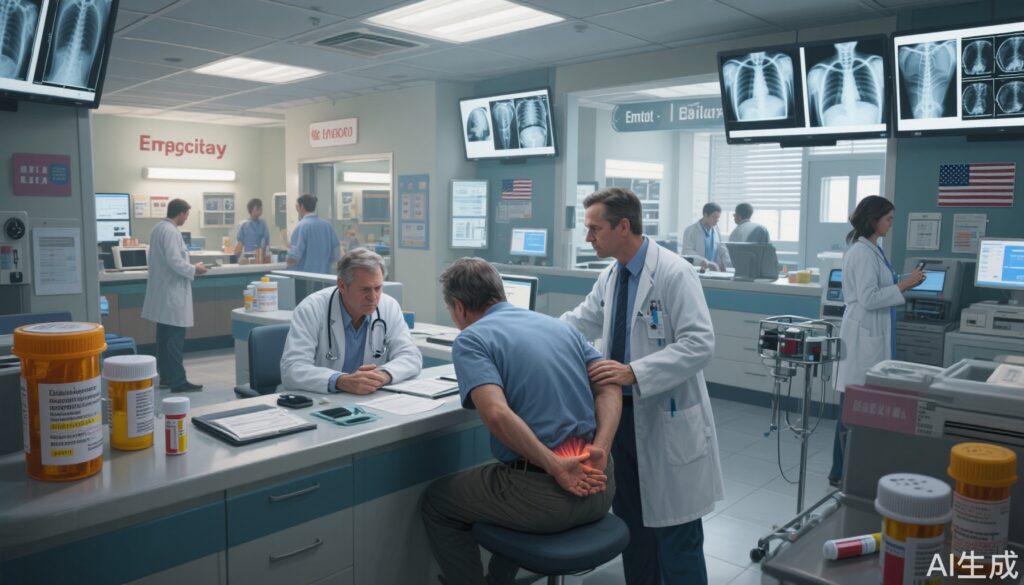Highlight
– From 2016 to 2022, 5.3% of all US emergency department (ED) visits were for low back pain, totaling an estimated 52.8 million visits.
– Opioid use for ED low back pain management declined significantly: administration dropped from 35.0% to 24.5%, and prescriptions decreased from 32.5% to 13.5%.
– Plain radiograph (X-ray) imaging remained common and stable, performed in 39.4% of cases, with higher rates in older adults.
– Advanced imaging (CT and MRI) was less frequent (5.4% and 3.2%, respectively).
Background
Low back pain remains a leading cause of disability, lost productivity, and healthcare utilization worldwide. In the United States, it is one of the most common complaints in emergency departments, posing significant challenges for acute pain management, diagnostic evaluation, and the avoidance of unnecessary interventions.
Historically, ED management of low back pain has been criticized for overreliance on opioid analgesics and excessive imaging, both of which have implications for patient safety, healthcare costs, and the potential for iatrogenic harm. Recent years have seen concerted efforts to reduce opioid prescribing, yet concerns persist about imaging practices and adherence to evidence-based guidelines.
Study Overview and Methodological Design
Fellner and Kim (2025) conducted a cross-sectional analysis using the National Hospital Ambulatory Medical Care Survey (NHAMCS), a robust, representative dataset capturing US ED utilization. The study period spanned 2016 to 2022, including 6,522 ED visits specifically for low back pain (mean age 45.4 years; 60.3% women; 56.4% non-Hispanic White), extrapolating to 52.8 million weighted visits nationwide.
The investigators assessed patterns in usual diagnostic and therapeutic care, focusing on opioid administration/prescription and imaging utilization (plain radiography, CT, MRI). Outcomes were stratified by age and temporal trends, but the analysis was descriptive rather than interventional. No control group or randomization was involved, consistent with the cross-sectional design.
Key Findings
– Low back pain accounted for 5.3% of all ED visits during the study window.
– Pain severity was substantial: mean pain score 7.2 out of 10.
– Opioid use for low back pain in the ED fell markedly:
– Opioid administration: 35.0% (2016) to 24.5% (2022)
– Opioid prescriptions at discharge: 32.5% (2016) to 13.5% (2022)
– Radiograph use was persistently high, at 39.4% overall, with minimal change over time.
– Advanced imaging (CT: 5.4%; MRI: 3.2%) was much less common.
– Patients aged 75 and older had the highest rates of both opioid prescribing and radiograph use.
Mechanistic Insights and Pathophysiological Context
Acute low back pain is frequently musculoskeletal, often self-limited, and rarely associated with serious underlying pathology. Opioid analgesics, while effective for short-term pain relief, carry risks of dependence, overdose, and adverse events. Imaging, particularly in the absence of red flag symptoms (e.g., neurologic deficit, suspicion of malignancy, or infection), rarely alters management but can lead to overdiagnosis and unnecessary interventions.
The observed decline in opioid prescribing aligns with national policy efforts, including CDC guidelines (2016, updated 2022) advocating for non-opioid therapies and careful risk-benefit assessment. However, the persistently high use of plain radiographs suggests ongoing gaps in the translation of Choosing Wisely and related guideline recommendations, which advise against routine imaging in uncomplicated cases.
Clinical Implications
For practicing clinicians, these findings reinforce the shift away from routine opioid use for ED low back pain, in keeping with best-practice guidelines and public health priorities. Alternative non-opioid analgesics (e.g., NSAIDs, acetaminophen) and patient education on the self-limited nature of most acute episodes are increasingly emphasized.
The stable, high rate of radiograph use—particularly among older adults—raises concerns about unnecessary imaging, radiation exposure, and downstream costs. While imaging may be warranted in select cases (e.g., trauma, new neurologic deficit, suspicion for fracture or infection), routine use in the absence of red flags is not supported by evidence. This suggests ongoing opportunities for quality improvement and provider education within emergency medicine.
Limitations and Controversies
As a cross-sectional analysis, the study cannot determine causal relationships or account for unmeasured confounders. NHAMCS data lack detailed clinical context (e.g., presence of red flag symptoms, prior imaging, or comorbidities) that might justify deviations from guideline-based care. The reliance on diagnostic codes may introduce misclassification bias, and trends in pain management or imaging in other care settings (primary care, urgent care) are not addressed.
Additionally, the observed reductions in opioid prescribing, while encouraging, must be balanced against the risk of undertreatment of severe pain—particularly in vulnerable populations such as older adults or those with complex comorbidities.
Expert Commentary or Guideline Positioning
The American College of Emergency Physicians and the American College of Physicians recommend against routine imaging for nonspecific low back pain and advocate for non-opioid first-line treatment. The CDC’s opioid prescribing guidelines (most recently updated in 2022) further emphasize judicious opioid use, reserving these agents for cases where benefits outweigh risks and non-opioid alternatives are inadequate.
Dr. Linda Nguyen, an emergency medicine specialist at University Hospital, notes: “While it’s heartening to see national declines in opioid prescribing for low back pain, the persistent overuse of imaging suggests we have more work to do in aligning ED practice with evidence and improving patient outcomes.”
Conclusion
This large, nationally representative study demonstrates substantial progress in reducing opioid prescribing for low back pain in US emergency departments over the past six years. However, the continued high use of plain radiography underscores a need for ongoing education and system-level interventions to ensure that imaging is reserved for patients most likely to benefit. Addressing both therapeutic and diagnostic stewardship in acute low back pain management remains essential for optimizing patient care and resource utilization.
References
1. Fellner A, Kim HS. Usual Care for Low Back Pain at United States Emergency Departments, 2016-2022. Ann Emerg Med. 2025 Jul 11:S0196-0644(25)00378-6. doi: 10.1016/j.annemergmed.2025.06.005.
2. Qaseem A, Wilt TJ, McLean RM, Forciea MA; Clinical Guidelines Committee of the American College of Physicians. Noninvasive Treatments for Acute, Subacute, and Chronic Low Back Pain: A Clinical Practice Guideline. Ann Intern Med. 2017;166(7):514-530.
3. Dowell D, Ragan KR, Jones CM, Baldwin GT, Chou R. CDC Clinical Practice Guideline for Prescribing Opioids for Pain — United States, 2022. MMWR Recomm Rep. 2022;71(3):1–95.
4. American College of Emergency Physicians. Choosing Wisely: Imaging for Low Back Pain. https://www.acep.org/clinical–practice-management/choosing-wisely. Accessed June 2024.



